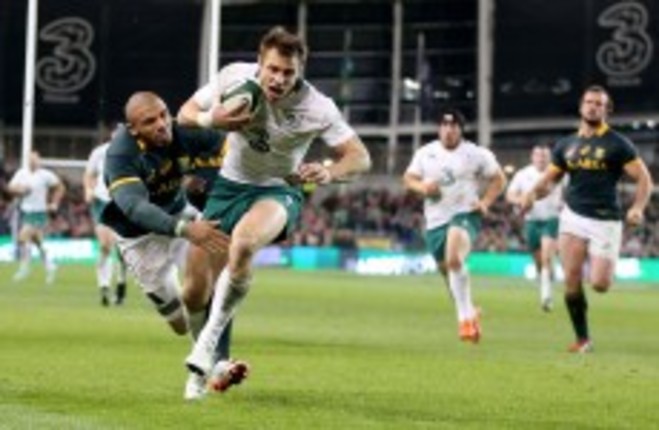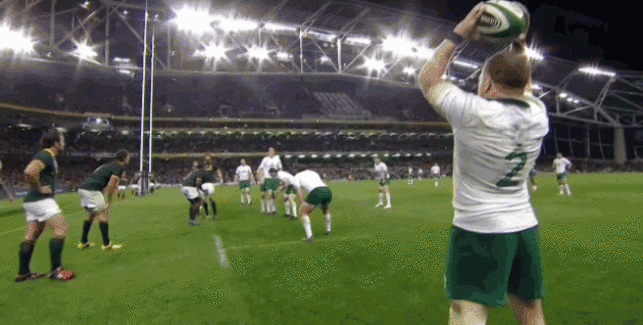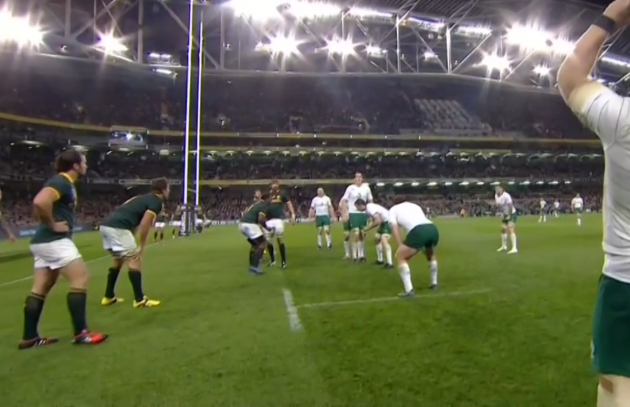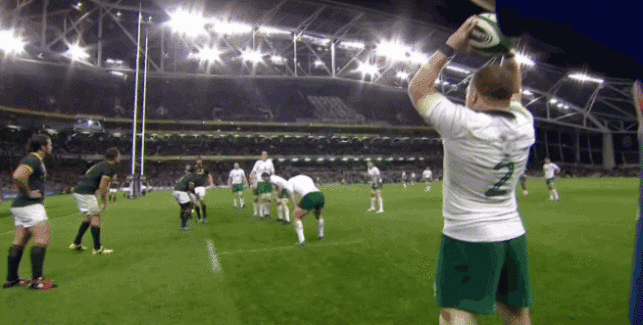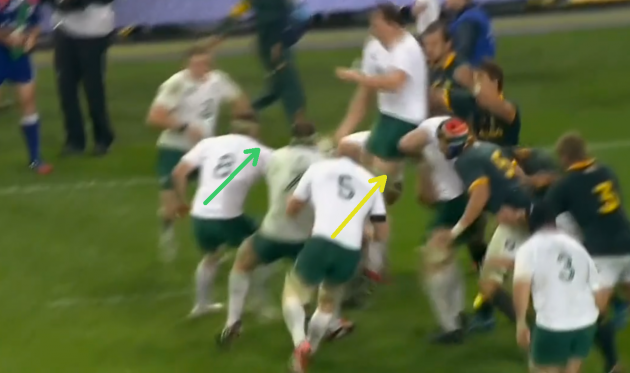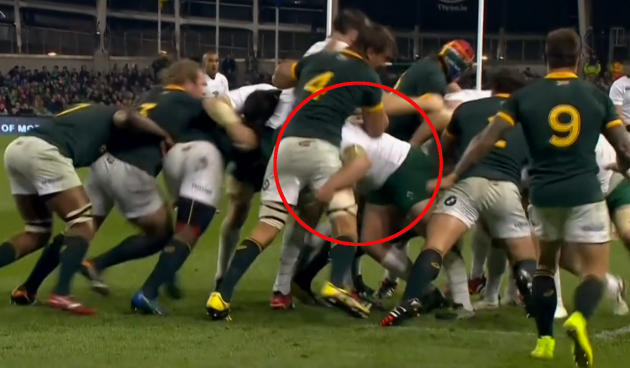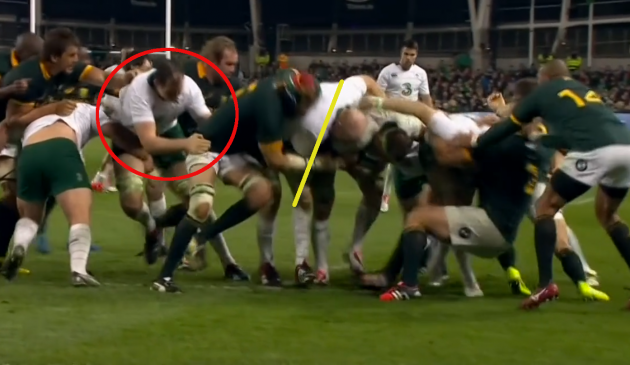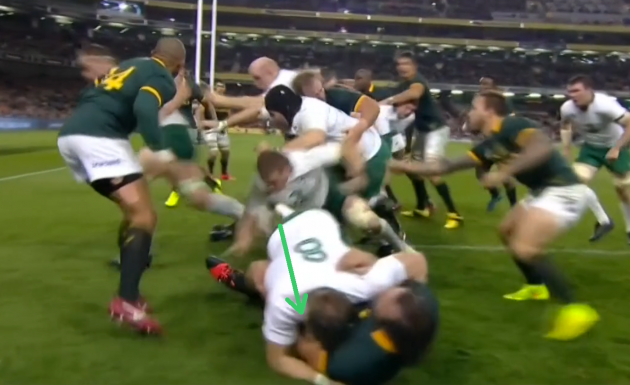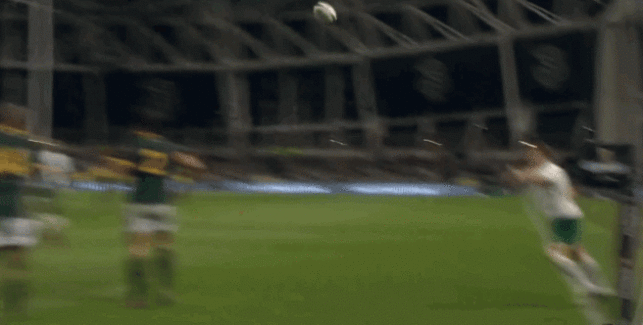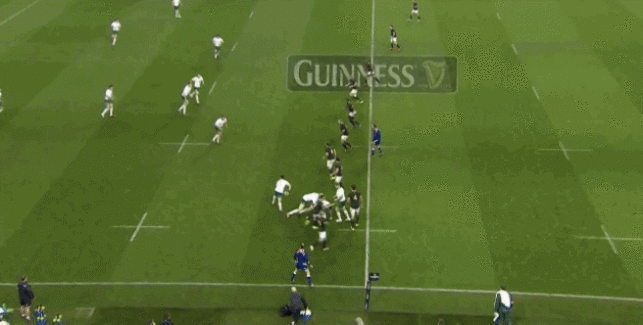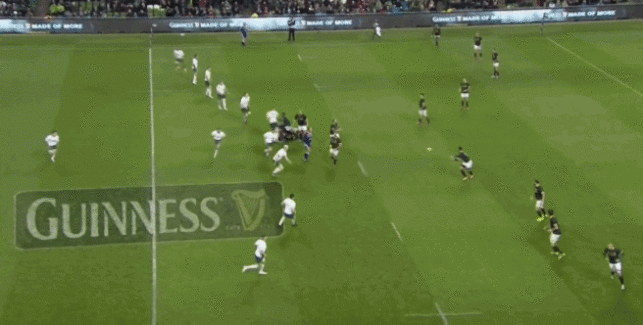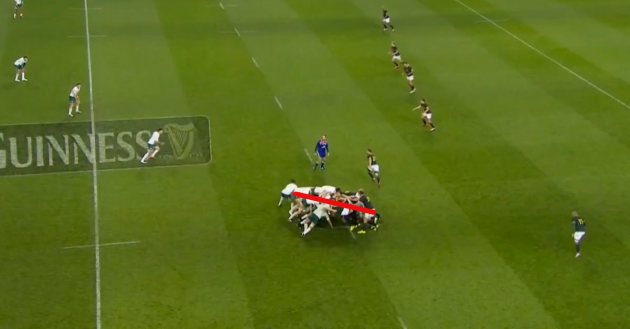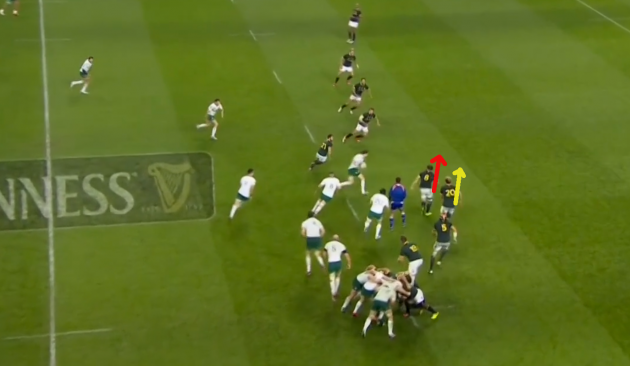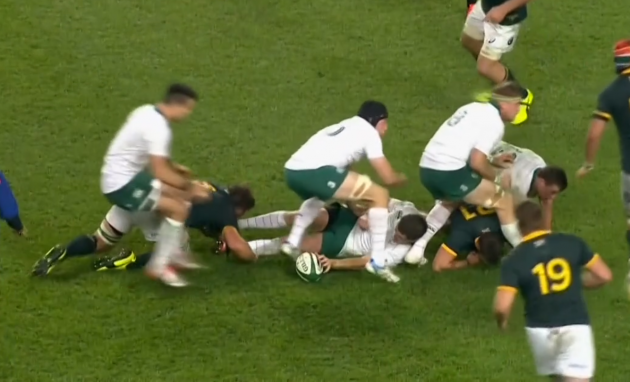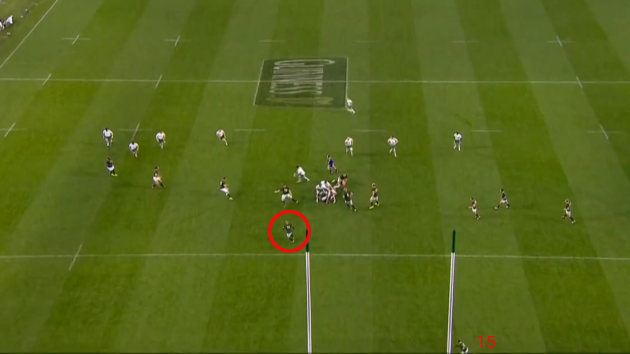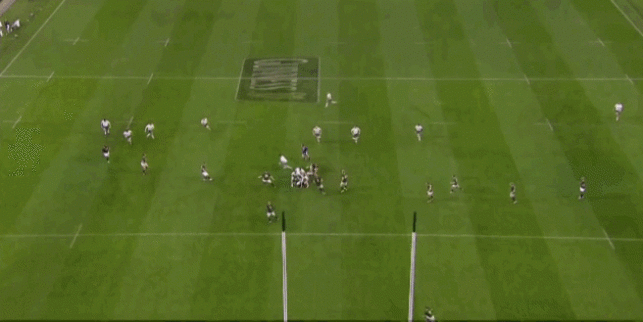WHILE IRELAND’S WIN over South Africa on Saturday evening was built on their wonderfully hungry defensive effort, tries for Rhys Ruddock and Tommy Bowe were of major importance too.
Increasingly, Joe Schmidt’s Ireland are becoming known for their intelligent, expertly-planned and accurate attacking performances, attributes that are illustrated in the tries they score.
There were several examples of Schmidt’s ‘power plays’ during last season’s Six Nations triumph, while Bowe’s was the latest example of those low-phase passages of attack that ruthlessly exploit an opposition weakness to bring about a score.
Schmidt demands the same accuracy from his forward pack in their maul attack, which was a pillar for Ireland last season. Despite the departure of John Plumtree, since replaced by Simon Easterby, the Irish pack again delivered an excellent maul try.
Role play
Watching the game live at the Aviva Stadium, the impression was that Ruddock had simply stumbled upon a gap in the South African maul defence by pure chance and used his power to burst through and score.
Therein lies the folly of judging rugby matches and players on a live viewing; there are so many little factors that can easily be missed.
The reality is that Ruddock’s try was a superbly-executed pre-planned line-out move in which each of the Irish forwards had a vital role to play.
First off, it’s worth examining Ireland’s set-up at the line-out.
Devin Toner [red circle] and Paul O’Connell [yellow] are the two realistic jumping options in this formation, with Jamie Heaslip [green] hovering in the ‘scrum-half’ position and apparently ready to be at the tail of the maul Ireland are almost certain to set up.
The Boks mark up on Toner and O’Connell with two defensive pods, leaving a space at the front of the line-out, which we see below. That’s exactly the area Toner is going to step into and exactly the spot where Ireland will look to break through.
A really simple bit of line-out movement takes Toner a stride forward, with Peter O’Mahony moving from in front of the second row to behind him to lift, while Jack McGrath lifts at the front.
As we can see, the Boks opt to stay on the ground and look to compete against the maul, rather than strive for a steal in the air. Cronin’s throw is accurate and allows Toner to catch with some ease.
The transfer of the ball is the next key for Ireland, and here’s where they do something different to what the Boks might have expected.
As we indicated above, Heaslip is in the scrum-half position at the start of the movement, and it’s a position from where he usually moves up to take the ball from the line-out jumper when Ireland maul.
Instead, Ruddock comes from behind the jump to accept the transfer in this instance. The image below is a little blurry as Ireland move to perform their roles swiftly, but we can made out the number seven on Ruddock’s back as he accepts the ball from Toner.
The flanker’s starting position in the line-out is behind Toner, then behind O’Mahony as the blindside flanker makes the move to lift Toner from behind the second row. Ruddock loops around both O’Mahony and Toner to take control of the ball.
Simultaneously, O’Connell [yellow arrow above] has made his own move from the back of the line-out, and is arriving on Ruddock’s right. On the Leinster man’s left is Heaslip [green arrow], and both these supporting players are essential to Ruddock scoring.
As those three central figures are getting into the above positions, loosehead prop McGrath is already moving onto his next duty having lifted Toner to win the ball in the air.
We see that task in the shot above, as McGrath drives forward beyond Toner and engages with Eben Etzebeth. The Springbok lock has eyes for the ball, but McGrath grabs him in and ties him down, effectively ensuring that Etzebeth can have no effect on stopping Ruddock.
O’Connell’s role is to block Matfield from getting at Ruddock and the ball. We see that in the screenshot below, indicated with a yellow line, as O’Connell binds onto Ruddock with his left arm and shields his back row from Matfield’s grasp.
It’s also worth highlighting Toner’s actions [red circle] in dragging Matfield back from the opposite side. On top of that, check out McGrath on the very left of the shot, still driving Etzebeth away from the ball.
These actions are typical of what Schmidt demands from his players, both backs and forwards.
‘How can I affect play even after my primary action is complete? Can I stay alive in the game even though the ball is not in my hands? What can I do to help the team make progress in this moment?’
Over on Ruddock’s left side, Heaslip is performing a similar role to O’Connell, shielding Ruddock from the arriving South Africa hooker Bismarck du Plessis.
The shot above comes as Ruddock is already dashing away to score, but highlights what Heaslip has done perfectly.
Sean Cronin and Mike Ross have assisted the Ireland No. 8 in shoring up the left-hand side for Ruddock, effectively taking du Plessis, Francois Hougaard and Cornal Hendricks out of the game.
It’s a wonderful example of a forward pack combining together, performing their individual roles in a synced-up manner and also being aggressive in doing so.
Ireland had identified a potential weakness at the front of the Boks’ line-out maul defence, and put into action a clever method of exploiting it. For forwards and coach Easterby alike, this would have been a hugely satisfying try.
Not that the backs did not play any part in creating it.
Like most tries, we can link the scoring acts back to decisive actions in the passages that have come before. It was a superb kick from Robbie Henshaw below that gave Ireland the territorial platform to score from [below].
A phase before the above kick, Tommy Bowe had superbly regathered his own contestable bomb, soaring above Hougaard to give Ireland important momentum [below].
Every single individual action adds up to the final product on the scoreboard.
Kick chase/contest, intelligent kicking for territory and the maul – three pillars of the Schmidt era so far.
Bowe’s beauty
Ireland’s second try was perhaps an example of each role adding up to a score that was more pleasing on they eye. Whatever about aesthetics, it was once again a five-pointer that came directly from the training ground.
This is a two-phase Schmidt special that takes advantage of the fact that South Africa are down to 14 men at the time. Ireland get a scrum in good field position after Willie le Roux knocks on, and instantly the players understand what needs to be done.
The first thing for Ireland is get the scrum right. It was an area in which the Boks held the advantage for much of the encounter, but on this occasion McGrath gets a vital nudge on Coenie Oosthuizen to allow Ireland’s scrum to shift up on the loosehead side.
The means Johnny Sexton can run onto the ball in a hugely advantageous position, with South Africa’s two back rows tied down in the scrum [they're missing a third with Bismarck du Plessis temporarily back on the pitch to cover for the sin binned Adriaan Strauss].
Replacement scrum-half Cobus Reinach is therefore isolated without a flanker inside him as cover as he comes up in defence, meaning Sexton can use his footwork to step into that gap and accelerate through.
As we see above, Duane Vermeulen and Schalk Burger are forced to run across and backwards to get to Sexton because of the angle the Irish scrum had battled into at the very beginning of the passage.
When Sexton is tackled, Ireland are already so far over the gainline that South Africa cannot get a player anywhere near the ball to attempt to slow it.
Robbie Henshaw, Jamie Heaslip and Tommy O’Donnell are present at the breakdown, which lasts less than two seconds and means South Africa are still attempting to catch up with play.
That is the essence of these power plays from Schmidt’s Ireland; strike with remarkable speed and accuracy in two or three phases, before the opposition defence can get into its ideal shape.
As Murray scoops the ball up from the breakdown after Sexton has been tackled, we can pinpoint the real weakness that Ireland are attempting to exploit here. Bryan Habana is circled in red below.
The South African left wing is almost directly behind the ruck at this point, having shifted into that position from a starting spot on the left-hand side of the scrum. In doing so, he leaves that wide open space deep to Ireland’s right to be kicked into.
In the screenshot above, we have highlighted the runs of Paul O’Connell and Devin Toner with green arrows too. They are decoys around the corner, and while it might not be the most important or glamorous role in this try, their animation on the left contributes to the end result.
Going back to Habana’s positioning, the camera angle below gives us a clearer illustration of the space available wide on South Africa’s left.
Willie le Roux at fullback is marked ’15′ and is even further across the pitch than Habana.
With Bowe holding width out of shot on the left and directly flat with Murray, anticipating and waiting for the kick, the Boks have left themselves in an irretrievable situation if the kick is accurate.
The Ireland scrum-half delivers in that regard, delivering in a role that he has practiced repeatedly in the build-up to this game.
That Ireland have scored a number of tries in this manner over the past year fills Schmidt’s men with confidence. The Kiwi coach and his analysis team of Mervyn Murphy and Vinny Hammond are consistently identifying these seemingly minor opposition weaknesses and coming up with ideal plans to exploit them.
Every time those plans work to perfection, the players become even more steadfast in their belief that if they perform in their individual roles, there will be a successful outcome.
With that confidence comes expectation and pressure; the burden of finding the next flaw to exploit. Where can Georgia be cut open? What is the Wallabies’ fundamental weakness?
Encouragingly, Ireland’s players under Schmidt continue to perform their jobs with conviction, aggression and accuracy. The head coach and his coaching staff will back themselves to keep the power plays coming.
